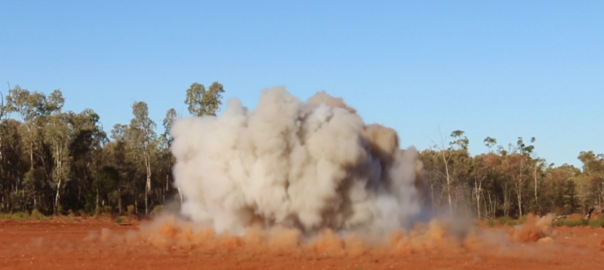In November, Mining3 says it achieved a significant milestone with the successful detonation of a world first hydrogen peroxide-based emulsion explosive as part of its alternative explosives project.
Using proprietary formulations, a series of trial blasts confirmed its ability to detonate, and provided early steps into the characterisation of this improved product, Mining3 said. “The new formulation is a major achievement in superseding water-gel/hydrogel formulations and a crucial advancement in product stability and sleep-time,” the company said.
Mining3 and the School of Mechanical and Mining Engineering at the University of Queensland are testing alternative explosive formulations, which eliminate the nitrogen component and replace it with hydrogen peroxide as the main oxidising agent. By removing the nitrogen component of the explosive formulation, it eliminates any NOx fumes generated after blasting, the partners said.
In its latest report, Mining3 reported on its emulsion developments: “Gums and emulsifiers, are the binding agents in water-gel and emulsions, respectively. Importantly, gums have a low-level organic contamination which leads to hydrogen peroxide degradation and limited current water-gel technology for manufacture-and-immediate-detonation applications.
“With synthetically produced emulsifiers, the material can be inert-to-hydrogen peroxide, lengthening the product stability to a significant period and enabling broader applications in the mining industry.”
Considerable effort has been invested in the pursuit of compatible emulsifiers, Mining3 said, and, with recent successes in detonation trials, it has made the past year of research “worthwhile”.
It continued: “Not only do we have a formulation with advanced oxidiser/fuel intimacy but also considerable advances in stability. Manufacture techniques have also maintained the ambient temperature methodology that gives the hydrogen peroxide-based explosives technology a distinct advantage in production cost.”
Over five days at RUREX, Australia’s only professional independent detonation testing range, upwards of 60 detonation tests were fired. Several other formulations were tested that will advance in the technology pipeline, but it is the confirmation of emulsion tests that was the most immediate success, according to Mining3.
This research has been supported by ACARP from its inception and transfer of this technology to the industry is eagerly anticipated, Mining3 added.
Dr Andrew Kettle, Senior Experimental Scientist and Project Executor, said: “These blasts have confirmed that we are pursuing the right pathway forward. We have invigorated enthusiasm going forward to further characterise the new emulsions in preparation for mine site trials in 2020. We are indebted, of course, to the ongoing support of ACARP and RUREX, and the vision of Mining3.”








